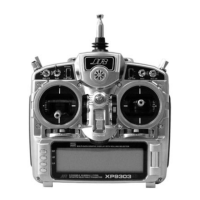PROG MIX – PROGRAMMABLE MIXERS
A38
The XP9303 System provides 4 Standard programmable
mixers (PROG.MIX3 - PROG.MIX6) and 2 Multi-Point
programmable mixers (PROG.MIX1 & PROG.MIX2).
Programmable mixers are used whenever the pilot wants
a channel to react or move as a result of providing input
to another channel, or to simply cause a channel to move
by moving a switch or lever. They are typically used to
compensate for deficiencies in aircraft design/setup, such
as eliminating pitch- and roll-coupling in knife-edge
flight, and to activate special aircraft functions like smoke
systems, speed brakes, bomb drops, idle-up, etc.
Multi-Point Mixing provides the ability to define a
customized “curve” of travel that the Slave channel will
follow as it reacts to the Master channel. It is different
from Normal Mixing in the sense that Normal Mixing
results in a linear movement of the Slave channel in
relation to the Master. With Multi-Point Mixing there are
7 points (including end points) along the travel of the
Master channel that can be adjusted to control the action
of the Slave channel (more or less travel in the same/
opposite direction) providing the ability to deviate from a
linear mixing action.
The channel that receives the original input from the pilot
is called the Master channel, while the channel that reacts
to the Master is called the Slave channel. Mixing occurs
when the pilot provides an input to the Master channel
by moving a stick, switch, or lever. The transmitter
automatically generates an input for the Slave channel
based on the pilot’s input to the Master channel and the
parameters defined in the programmable mixer.
Mixes are programmable, allowing any of the 9 channels
to be Master, Slave or both. The mixing parameters are
also programmable and include the direction of travel
of the Slave channel; the amount of travel for the Slave
channel; the Offset (where the mix starts and changes
direction) and the switches/levers/sticks that are used
to turn a mixer on and off. All of these elements are
adjustable in Programmable Mixers.
Some examples of how programmable mixers might be
used include but are certainly not limited to:
• Eliminate Roll-Coupling where the aircraft rolls
when there is Rudder input. The mixer causes the
Ailerons to move just a little bit in the opposite
direction of the Rudder in order to keep the aircraft
from rolling, while holding Rudder for knife-edge
flight. This standard mixer would designate the
Rudder as the Master and the Ailerons as the
Slave.
• Eliminate Pitch-Coupling where the aircraft
pitches to the gear or canopy when holding Rudder
for knife-edge flight. The mixer causes the Elevator
to move a little when Rudder is applied to keep
the aircraft from pitching while holding Rudder
during knife-edge flight. This Multi-Point mixer
would designate the Rudder as the Master and the
Elevator as the slave. A Multi-Point mixer would
be used because pitch-coupling is typically non-
linear in nature and requires a customized curve
to counteract pitching that is induced by different
amounts of Rudder deflection.
• Eliminate pulling out on down lines where
the aircraft has a tendency to pull out towards the
canopy when flying vertical down lines at idle.
The mixer generates a bit of down Elevator when
the throttle stick is pulled back to idle, making the
aircraft track straight down with no input from the
pilot. This mixer would designate the Throttle as
the Master and the Elevator as the Slave and would
be turned on and off with a switch so the down
Elevator would not be generated during landing.
• Controlling a Smoke System where a switch
is used to activate the smoke system and once
activated, the smoke system comes on when the
throttle stick is advanced beyond a certain point.
This standard mixer would designate Throttle as
the Master and an Auxiliary channel as a slave and
would be turned on and off by a switch.
• Idle-Up where flipping a switch causes the engine
RPM to increase a bit at idle to protect against
a flameout during flying and then returning to
low idle for landing. This standard mixer would
designate an auxiliary channel as the Master and
the Throttle channel as the Slave. It would also use
a switch to turn the mixer on and off.
The possibilities are endless and limited only by the
imagination.

